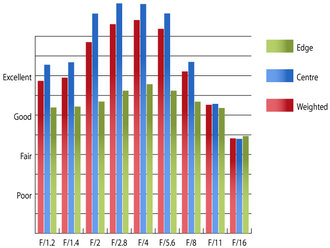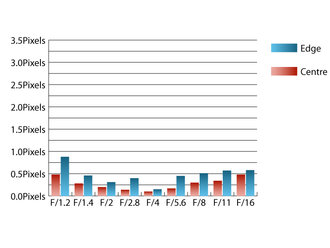Nikon 1 Nikkor 32mm f/1.2 Lens Review
Nikon 1 Nikkor 32mm f/1.2 Performance
At maximum aperture sharpness in the centre of the frame is already excellent and clarity towards the edges of the frame is good. Stopping down to between f/2 and f/5.6 results in a dramatic increase in clarity to outstanding levels. It's a shame the sharpness towards the edges of the frame doesn't improve as much, although it is very good between f/2.8 and f/5.6.  Resolution @ 32mm | How to read our chartsThe blue column represents readings from the centre of the picture frame at the various apertures and the green is from the edges. Averaging them out gives the red weighted column.The scale on the left side is an indication of actual image resolution. The taller the column, the better the lens performance. Simple. For this review, the lens was tested on a Nikon 1 V2 using Imatest. |
Chromatic aberrations are a little high towards the edges of the frame at maximum aperture, exceeding 0.8 pixel widths. This level of fringing may become visible in images, especially along high contrast edges near the outer areas of the frame.
 Chromatic aberration @ 32mm | How to read our chartsChromatic aberration is the lens' inability to focus on the sensor or film all colours of visible light at the same point. Severe chromatic aberration gives a noticeable fringing or a halo effect around sharp edges within the picture. It can be cured in software.Apochromatic lenses have special lens elements (aspheric, extra-low dispersion etc) to minimize the problem, hence they usually cost more. For this review, the lens was tested on a Nikon 1 V2 using Imatest. |
Falloff of illumination towards the corners of the frame is remarkably well controlled. At f/1.2 the corners are only 1.08 stops darker than the image centre and visually uniform illumination is achieved with the aperture stopped down to f/2.8 or beyond.
A slight amount of barrel distortion is typical with fast aperture lenses. Imatest detected 0.9% barrel distortion, which should pose few issues for general picture taking. If absolutely straight lines are required, you'll be glad to learn that the distortion pattern is uniform across the frame, so applying corrections in image editing software should be quite straightforward.
Nikon's Nano-Crystal coatings do a great job of suppressing flare and rettaining contrast much of the time. Under particularly harsh lighting, flare can occur and contrast can be lost, especially at fast apertures. In these cases it's advisable to use the supplied lens hood, which attaches to the lens via a bayonet fitting. Additional sample photos are available in the Equipment Database.
Add your message
Login required
Please login here or if you've not registered, you can register here. Registering is safe, quick and free.
Please login here or if you've not registered, you can register here. Registering is safe, quick and free.
photodo Stats
1102 lenses
428 MTF tests
74 in-depth photodo reviews
100+ users join each day
Help the lens community by reviewing or rating a lens today via our lens search
428 MTF tests
74 in-depth photodo reviews
100+ users join each day
Help the lens community by reviewing or rating a lens today via our lens search
Latest Lens Reviews
- Chinon 28mm f/2.8 Vintage Lens Review
- Canon EF 70-200mm f/4L IS II USM Lens Review
- Samyang AF 85mm f/1.4 EF Review
- Sigma 70mm f/2.8 DG Macro Art Review
- Samyang AF 24mm f/2.8 FE Review
- Meike 50mm f/1.7 Review
- Tamron 70-210mm f/4 Di VC USD Review
- Lensbaby Burnside 35mm f/2.8 Review
- Asahi Super Takumar 50mm f/1.4 Review
- Asahi Super-Multi-Coated Takumar 135mm f/3.5 Review
